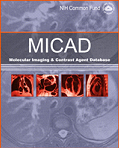 Science Highlights
Science Highlights
The Molecular Libraries and Imaging Program Continues to Pay Dividends After Leaving the Common Fund
 The Common Fund’s Molecular Libraries and Imaging (MLI) Program has made promising inroads in the development of new therapeutics for human disease. A compound initially discovered by the NIH Molecular Libraries Probe Production Center at The Scripps Research Institute (TSRI), which was a part of the MLI program, was a precursor to the drug candidate ozanimod; which is currently in two Phase III clinical trials – one for patients with relapsing multiple sclerosis and the other in patients with ulcerative colitis. Dr. Hugh Rosen, a professor at TSRI was a Center Principal Investigator in the MLI program and one of the discoverers of ozanimod. Researchers screened the NIH MLI collection to find allosteric modulators of the sphingosine 1 phosphate receptor 1 (S1P1). Compounds identified in the screen were then optimized for safety and effectiveness in man, resulting in the clinical candidate ozanimod (formerly RPC1063).
The Common Fund’s Molecular Libraries and Imaging (MLI) Program has made promising inroads in the development of new therapeutics for human disease. A compound initially discovered by the NIH Molecular Libraries Probe Production Center at The Scripps Research Institute (TSRI), which was a part of the MLI program, was a precursor to the drug candidate ozanimod; which is currently in two Phase III clinical trials – one for patients with relapsing multiple sclerosis and the other in patients with ulcerative colitis. Dr. Hugh Rosen, a professor at TSRI was a Center Principal Investigator in the MLI program and one of the discoverers of ozanimod. Researchers screened the NIH MLI collection to find allosteric modulators of the sphingosine 1 phosphate receptor 1 (S1P1). Compounds identified in the screen were then optimized for safety and effectiveness in man, resulting in the clinical candidate ozanimod (formerly RPC1063).
Launched in 2004 as one of the original NIH Roadmap programs, the primary intent of MLI was to empower the research community to use small molecule compounds (probes) to study the functions of genes and pathways. The most surprising and encouraging findings, however, have been the great strides MLI is making in drug discovery. The topic of the “Valley of Death” – getting promising scientific breakthroughs made at the bench to the patients, continues to be a high priority area in the biomedical community. The academic approach employed by MLI, in conjunction with the Common Fund’s Structural Biology program, allowed for the exploration of basic biological mechanisms that led to the discovery of a lead compound, the crystal structure of S1P1, and the discovery of the binding site for the compound.
Dr. Rosen is now on the hunt for another drug candidate that has its roots in the MLI program. He will co-direct, as part of the NIH’s Blueprint Neurotherapeutics Network, a project that focuses on a candidate migraine treatment to be tested in preclinical studies. The grant for this project is funded through the National Institute of Neurological Disorders and Stroke.
References:
Celgene bets big on Scripps-originated autoimmunity candidate. Cully M. Nature Reviews Drug Discovery. 21 August 2015. 14(9): 595.
EurekAlert! Press Release from Scripps Research Institute
MOLECULAR LIBRARIES DISCOVERY LEADS TO PHASE 1 CLINICAL TRIAL FOR MULTIPLE MYELOMA
 A compound originally identified with the support of the Molecular Libraries program has led to a drug candidate now entering a Phase 1 clinical trial in patients with multiple myeloma that has proved resistant to two or more established treatment options. The experimental compound, CB-5083, inhibits a protein called p97 that is critical to many cellular functions, including cell division. CB-5083 is derived from a compound called ML240 that was initially identified by Dr. Tsui-Fen Chou, working in the laboratory of Dr. Raymond Deshaies at Caltech. To identify ML240, Drs. Chou and Deshaies collaborated with members of the Molecular Libraries Probe Production Centers Network, including the Scripps Molecular Screening Center and the Specialized Chemistry Center at the University of Kansas. Ongoing research with CB-5083 has shown promise in treating other types of cancer in mice, and Phase 1 clinical trials for CB-5083 in the treatment of solid tumors are expected to start later this year.
A compound originally identified with the support of the Molecular Libraries program has led to a drug candidate now entering a Phase 1 clinical trial in patients with multiple myeloma that has proved resistant to two or more established treatment options. The experimental compound, CB-5083, inhibits a protein called p97 that is critical to many cellular functions, including cell division. CB-5083 is derived from a compound called ML240 that was initially identified by Dr. Tsui-Fen Chou, working in the laboratory of Dr. Raymond Deshaies at Caltech. To identify ML240, Drs. Chou and Deshaies collaborated with members of the Molecular Libraries Probe Production Centers Network, including the Scripps Molecular Screening Center and the Specialized Chemistry Center at the University of Kansas. Ongoing research with CB-5083 has shown promise in treating other types of cancer in mice, and Phase 1 clinical trials for CB-5083 in the treatment of solid tumors are expected to start later this year.
Read the press release from Cleave Biosciences.
Read more about the Molecular Libraries contribution to CB-5083 in the Common Fund 10 Year Commemoration Book, under the “Molecular Libraries and Imaging” section.
 MOLECULAR LIBRARY PROBE TO BE FURTHER DEVELOPED INTO A THERAPEUTIC
MOLECULAR LIBRARY PROBE TO BE FURTHER DEVELOPED INTO A THERAPEUTIC
 ML probe #341, a compound developed by the NIH Molecular Libraries Probe Production Center at the Broad Institute of MIT and Harvard University, which is part of the NIH Common Fund Molecular Libraries Program, has been chosen for further development by The Global Health Innovative Technology (GHIT) fund as a candidate therapeutic for Chagas disease. The GHIT fund was launched in May, 2013 to bring the knowledge and ability of the Japanese pharmaceutical industry to better address infectious diseases that disproportionately affect those living in poverty around the world. The GHIT is a tripartite partnership including a consortium of five of Japan's biggest pharmaceutical companies, the Japanese government, and the Bill and Melinda Gates Foundation. Chagas disease is caused by the parasite Trypanosoma cruzi, which is transmitted to humans and other animals via blood-sucking insects. The disease is endemic to the Americas, chiefly infecting those in poverty-stricken rural areas of Latin America. This new funding lends support that could potentially lead to new therapeutics for this significant parasitic disease.
ML probe #341, a compound developed by the NIH Molecular Libraries Probe Production Center at the Broad Institute of MIT and Harvard University, which is part of the NIH Common Fund Molecular Libraries Program, has been chosen for further development by The Global Health Innovative Technology (GHIT) fund as a candidate therapeutic for Chagas disease. The GHIT fund was launched in May, 2013 to bring the knowledge and ability of the Japanese pharmaceutical industry to better address infectious diseases that disproportionately affect those living in poverty around the world. The GHIT is a tripartite partnership including a consortium of five of Japan's biggest pharmaceutical companies, the Japanese government, and the Bill and Melinda Gates Foundation. Chagas disease is caused by the parasite Trypanosoma cruzi, which is transmitted to humans and other animals via blood-sucking insects. The disease is endemic to the Americas, chiefly infecting those in poverty-stricken rural areas of Latin America. This new funding lends support that could potentially lead to new therapeutics for this significant parasitic disease.
Read more about the new GHIT fund projects here.
Read more about ML #341 here.
 FROM BENCH TO BEDSIDE: THERAPEUTIC CANDIDATE TARGETING S1P1 ADVANCES IN CLINICAL TRIALS FOR MULTIPLE SCLEROSIS
FROM BENCH TO BEDSIDE: THERAPEUTIC CANDIDATE TARGETING S1P1 ADVANCES IN CLINICAL TRIALS FOR MULTIPLE SCLEROSIS

Receptos, Inc. announced in December, 2013 that they have completed an analysis of the Phase 2 portion of its Phase 2/3 trial of RPC1063 in relapsing multiple sclerosis (RMS). A compound initially discovered by the NIH Molecular Libraries Probe Production Center at The Scripps Research Institute, which is part of the NIH Common Fund Molecular Libraries Program, was used as a precursor in the development of RCPT1063 by Receptos Inc. Based on these new findings, the compound has been approved for continuation of the Phase 2 portion as well as initiation of the Phase 3 portion of the study. This is an important milestone, because in phase 3 the treatment is given to large groups of people to while comparing it to commonly used treatments. Phase 3 is the last phase prior to FDA evaluation of a new drug. As of January 2014, Receptos has actively enrolled the first patients for the phase 3 portion of the trial.
STUDY USING NIH CLINICAL COLLECTION LEADS TO DISCOVERY OF A POSSIBLE LITHIUM REPLACEMENT FOR BIPOLAR DISORDER TREATMENT

Mental illness is a serious burden on a global scale. Bipolar disorder is estimated to affect anywhere between 1-3% of the global population. Despite the high burden, little progress has been made for treating the disorder since the introduction of lithium as a treatment in 1949. A major concern is that twice the prescribed dose can be potentially lethal. There are also numerous well-documented side effects. However, a research team from Oxford University has utilized the NIH Common Fund Supported Clinical Collection to discover an enticing lithium replacement. The NIH Clinical Collection comprises small molecules that have a history of use and safety in human clinical trials. In a study published in Nature Communications, the research team has found that the chemical ebselen targets inositol monophosphatase, the enzyme that has been suggested as a possible target for lithium as well. Ebselen appears in mice to more specifically work with this target than lithium, with similar efficacy. These findings show that this target may be used in industry for new drug discoveries and also shows promising results that ebselen, a compound tested in humans, may be a viable option for bipolar disorder treatment.
Reference
Singh N, Halliday AC, Thomas JM, Kuznetsova OV, Baldwin R, Woon EC, Aley PK, Antoniadou I, Sharp T, Vasudevan SR, Churchill GC. A safe lithium mimetic for bipolar disorder. Nat Commun. 2013;4:1332. PMID: 23299882
NEW APPROACH TO ATTACKING VIRUSES: RESEARCHERS DISCOVER EFFECTIVE INHIBITOR TO CONTROL HERPESVIRUS INFECTION AND REACTIVATION

Members of the herpesvirus family establish life-long dormant infections in people that can reactivate at any time to cause disease. Presently, there has been a focus on treatments that target the late stages of infection in those with herpes, particularly simplex virus (HSV) types 1 and 2, which cause oral and genital herpes. Furthermore, serious illness occurs when immune-compromised patients previously infected with another type of herepesvirus, human cytomegalovirus (CMV) suffer a reactivation. To date, drugs have been developed to target late stages of infection, with some success. In a new study, a probe developed from the NIH Chemical Genomics Center (NCGC), which is funded by the NIH Common Fund Molecular Libraries program, has been shown to be effective during lab studies at repressing early expression genes and therefore preventing infections from establishing. This molecule works by targeting human proteins to fight infections. Their studies also demonstrate that reactivation can be inhibited by the probe compound. Overall, there are implications for the prevention of infections as well as long-term treatment in infected patient to prevent reactivation episodes.
This new area of research is beginning to show results for a number of viral diseases.
Read more about this research advance here.
Reference:
Liang Y, Vogel JL, Arbuckle JH, Rai G, Jadhav A, Simeonov A, Maloney DJ, Kristie TM. Targeting the JMJD2 Histone Demethylases to Epigenetically Control Herpesvirus Infection and Reactivation from Latency. Sci Transl Med. 2013 Jan 9. PMID: 23303604.
 TEACHING OLD DRUGS NEW TRICKS: RESEARCHERS IDENTIFY NEW USES FOR A CLASS OF DRUGS TO TREAT HARMFUL MICROBES
TEACHING OLD DRUGS NEW TRICKS: RESEARCHERS IDENTIFY NEW USES FOR A CLASS OF DRUGS TO TREAT HARMFUL MICROBES

Discovering and developing new compounds into human therapeutics is an odious task. Current estimates suggest each new drug takes 10-15 years to develop at a cost upwards of two billion dollars. In addition to this high cost and length of time, several pathogenic microbes are increasingly becoming resistant to multiple antibiotics. For example, multidrug-resistant Acinetobacter infections are becoming a serious issue in hospitals. A population particularly affected has been US soldiers that have suffered combat wounds. One way to aid in the treatment of difficult to manage infections is to examine compounds that have already been approved for human use, a process known as drug repurposing or repositioning. The discovery of a class of known compounds whose repurposing may be useful in treating multidrug-resistant Acinetobacterinfections could lead to the development of broad-spectrum antimicrobials that could become useful in the clinical setting, both for civilians and military personnel. The NIH Clinical Collection (NCC) is an array of approximately 450 small molecules that have been approved by the FDA for use in humans. This collection was assembled and is funded by the NIH Common Fund Molecular Libraries program. Using the collection to testAcinetobacter isolates that were obtained from persistent wounds of US soldiers and Marines injured in the Middle East, researchers were able to identify a class of four compounds, all rifamycins, which were effective in concentrations that are achievable in humans for preventing growth of multidrug-resistant Acinetobacter strains. Furthermore, the compounds were also effective when tested against select agents including the bacterial species responsible for anthrax and plague, providing a potential countermeasure in the event of a biological attack.
Reference:
Chromy BA, Elsheikh M, Christensen TL, Livingston D, Petersen K, Bearinger JP, Hoeprich PD. Repurposing screens identify rifamycins as potential broad-spectrum therapy for multidrug-resistant Acinetobacter baumannii and select agent microorganisms. Future Microbiology, 2012 Aug 7.
Up to Top
 SLOWING CANCER CELLS: NEW FINDINGS INCREASE MOLECULAR UNDERSTANDING OF TUMOR GROWTH
SLOWING CANCER CELLS: NEW FINDINGS INCREASE MOLECULAR UNDERSTANDING OF TUMOR GROWTH

Cancer cells need more sugar than average mammalian cells so that they can replicate rapidly to form tumors. Pyruvate kinase, an enzyme that is fundamental for converting glucose to cellular building blocks and energy, has been long studied in an attempt to understand cancer cell metabolism. In a new advance for the cancer field, a team of researchers, funded in part by the NIH Common Fund’s Molecular Libraries and Imaging program, have characterized molecules that activate a specific form of the enzyme, pyruvate kinase m2 (PKM2). It has been known that cancer cells use PKM2 instead of PKM1 because its slower activity promotes the accumulation of glucose byproducts that can be used as building blocks for new cancer cells instead of for metabolic energy. The Molecular Libraries and Imaging program supported a collaboration between the laboratory of Dr. Matthew Vander Heiden of the Koch Institute for Integrative Cancer Research at Massachusetts Institute of Technology and the NIH Chemical Genomics Center (NCGC) screening center to identify molecules that selectively activate PKM2. In a newly published study, the research team tested the molecules in mice and illustrated that the addition of the compounds interfered with the ability of cancer cells to form tumors. They then determined the structure and properties of the molecules and showed that the molecules bind to a region of the enzyme different from that bound by the natural activator of PKM2. The novel binding mechanism is critical because it allows the molecules to resist natural inactivating proteins. Thus, discovery of this mechanism may facilitate the design of experimental cancer therapeutics that effectively activate PMK2. This research is still in its early stages, but Dr. Vander Heiden’s team and others now have insightful information that may ultimately prove valuable in the fight against several types of cancers.
 COMMON FUND RESEARCHERS UNCOVER STRUCTURE OF IMPORTANT TARGET FOR DRUG DESIGN
COMMON FUND RESEARCHERS UNCOVER STRUCTURE OF IMPORTANT TARGET FOR DRUG DESIGN

Researchers supported by the NIH Common Fund and the National Institute of General Medical Sciences teamed up to characterize an important G Protein-coupled receptor (GPCR). GPCRs are a class of membrane proteins involved in an array of physiological functions and human diseases, including multiple sclerosis. Importantly, these receptor proteins are the target of approximately 40% of all medications currently on the market. Using technology developed in part through support from the Common Fund’s Structural Biology Program, the research teams of Drs. Raymond Stevens and Hugh Rosen at The Scripps Research Institute teamed up to examine the GPCR sphingosine 1-phosphate 1 (S1P1) bound to different activators and inhibitors developed through the Common Fund’s Molecular Libraries and Imaging Program. S1P1 receptors play critical roles in controlling multiple sclerosis and other diseases, making the discovery useful for advancing treatment options. Advances made in this study allowed the researchers to identify how molecules bind in different ways to the receptor and better understand at a detailed level how access to the binding pocket is gained. These advances pave the way for more targeted drug design that will yield highly effective therapeutics with fewer side effects than current treatments. These findings were published in the February 17, 2012 issue of the journal Science.
- Read the NIH press release
- Read more about the Molecular Libraries and Imaging program…
- Read more about the Structural Biology program…
Reference:
Hanson MA, Roth CB, Jo E, Griffith MT, Scott FL, Reinhart G, Desale H, Clemons B, Cahalan SM, Schuerer SC, Sanna MG, Han GW, Kuhn P, Rosen H, Stevens RC. Crystal structure of lipid G protein-coupled receptor. Science, 2012 Feb 17; 335(6070): 851-5. PMID: 22344443.
Up to Top
 MOLECULAR IMAGING AND CONTRAST AGENT DATABASE (MICAD):
MOLECULAR IMAGING AND CONTRAST AGENT DATABASE (MICAD):

The Molecular Imaging and Contrast Agent Database (MICAD) is an online source of scientific information and a key component of the Molecular Libraries and Imaging program funded by the NIH Common Fund. Currently, there are over 1000 cu rated entries for agents in various categories including but not limited to compounds, antibodies and peptides. MICAD is ranked in the top 5% of page views (hits) for the National Center for Biotechnology Information (NCBI) Bookshelf. MICAD is also ranked in the top 1% for PDF downloads on the NCBI Bookshelf. These statistics demonstrate that MICAD has and will continue to be beneficial to the scientific community. In addition, MICAD is continuously updated to reflect new information about existing compounds which also includes new entries for previously unlisted agents in the database.
Up to Top
 NEW UNDERSTANDING OF DANGEROUS FLU-RELATED COMPLICATION
NEW UNDERSTANDING OF DANGEROUS FLU-RELATED COMPLICATION

The immune system is often thought of as an ally in the fight against invading pathogens that make us sick. But in the attempt to destroy pathogens, sometimes the immune system’s response can be more harmful than the invaders it is trying to defend against. In the 1918 Spanish flu pandemic and the recent avian and swine flu outbreaks, scientists have proposed that an excessive immune reaction flooded patients’ lungs with fluid and disease-fighting cells, contributing to the abnormally high fatality rate. This severe immune reaction involves the production of large amounts of proteins called cytokines, and hence is often called a “cytokine storm.” Because cytokine storm can be deadly, medical interventions aimed at blunting this response are extremely desirable.
Recent work by Dr. Hugh Rosen, a researcher in the Common Fund’s Molecular Libraries and Imaging program, has led to a breakthrough in our understanding of the biological processes underlying cytokine storm. In a study published in the September 16, 2011 issue of Cell, Dr. Rosen and colleagues identify a small molecule compound that blocks cytokine storm and improves survival in mice infected with a strain of influenza virus that is normally fatal. This compound interacts with a protein called S1P1, a receptor on the surface of cells that binds to specific molecules and elicits a cellular response. When the researchers treated influenza-infected mice with the compound, they discovered that the cytokine storm response was diminished and survival was improved. Intriguingly, the researchers also discovered that the cells coordinating cytokine storm were not immune cells or cells from the inner surface of the lungs, as was previously thought. Instead, the cytokine storm was mediated by endothelial cells, which line the inside of blood vessels. These new insights about the role of endothelial cells and the S1P1 protein in the development of the cytokine storm response may help scientists predict which patients are most at risk for this potentially deadly complication, and also suggests potential new therapeutic targets for drug development efforts.
References:
Teijaro JR, Walsh KB, Cahalan S, Fremgen DM, Roberts E, Scott F, Martinborough E, Peach R, Oldstone MBA, and Rosen H. Endothelial cells are central orchestrators of cytokine amplification during influenza virus infection. Cell, September 16, 2011. 146(6):980-991. PMID: 21925319
Iwasaki A and Medzhitov R. A new shield for a cytokine storm. Cell, September 16, 2011. 156(6): 861-2. PMID: 21925310.
 FINDING A PERFECT MATCH – MATCHMAKING BY THE MOLECULAR LIBRARIES PROGRAM
FINDING A PERFECT MATCH – MATCHMAKING BY THE MOLECULAR LIBRARIES PROGRAM


A continent apart, synthetic chemist Dr. Gregory Fu, of MIT, Cambridge, MA and Dr. Ben Cravatt of Scripps, La Jolla, CA formed a productive scientific collaboration after a unique series of chemicals Dr. Fu donated to a public repository was found to inhibit a protein of interest to Dr. Cravatt. Dr. Fu created novel aza-β-lactam (ABL) compounds, relatives of penicillin and other β-lactam antibiotics, and provided them to the Common Fund-supported Molecular Libraries Small Molecule Repository. This public resource contains over 350,000 different chemical compounds that are distributed to a network of centers for screening in high throughput assays submitted by the research community. Using an assay designed by Dr. Cravatt, the Molecular Libraries screening center at Scripps discovered that four of Dr. Fu’s novel ABLs inhibited protein phosphatase methyltransferase-1 (PME-1), a protein that has no previously known inhibitors. In work published in PNAS (read the press release ), the collaborators discovered that Dr. Fu’s novel inhibitors block PME-1 activity in cells and in mice, resulting in increased activity of PME-1’s target, the major protein phosphatase, protein phosphatase 2A (PP2A). Previous research has suggested that PME-1 and PP2A may play a role in cancer growth and Alzheimer’s disease, but the lack of inhibitors for PME-1 hindered scientists’ ability to investigate these possibilities. The newly discovered inhibitors will help researchers decipher the contributions of PME-1 and PP2A to cancer and neurodegenerative disease.
Reference:
Bachovchin DA, Mohr JT, Speers AE, Wang C, Berlin JM, Spicer TP, Fernandez-Vega V, Chase P, Hodder PS, Schurer SC, Nomura DK, Rosen H, Fu GC, Cravatt BF. Academic cross-fertilization by public screening yields a remarkable class of protein phosphatase methylesterase-1 inhibitors. Proceedings of the National Academy of Sciences, 2011 Apr 26; 108(17): 6811-6. Epub 2011 Mar 11. PMID: 21398589.
 FROM THE LAB TO THE CLINIC: DISCOVERY FROM MOLECULAR LIBRARIES PROGRAM ENTERS CLINICAL TRIALS
FROM THE LAB TO THE CLINIC: DISCOVERY FROM MOLECULAR LIBRARIES PROGRAM ENTERS CLINICAL TRIALS

Researchers in the Common Fund’s Molecular Libraries and Imaging program are tackling a tough biological problem—finding potential drug candidates that target G protein-coupled receptors (GPCRs). Dr. Hugh Rosen, funded in part by the Molecular Libraries and Imaging program, is a scientific founder of Receptos, Inc., a GPCR drug discovery and development company. GPCRs are proteins found on the cell membrane that transmit signals from the outside of the cell to elicit responses inside the cell. GCPRs play many important roles in the body, including hormone signaling, cellular communication in the brain, vision, and cardiac function. Because GPCRs are crucial to many biological processes, they are also implicated in a number of different diseases. One such GPCR, called sphingosine-1-phosphate receptor 1 (S1P1), plays a role in multiple sclerosis, an inflammatory and autoimmune disease which causes damage to the protective myelin sheaths of nerve cells and to the underlying nerve fibers. The current focus of Receptos, Inc. is to conduct clinical trials for a novel compound that targets S1P1, called RPC1063, in the hopes that this potential treatment will suppress circulating immune cells to blunt the underlying cause of multiple sclerosis. The discovery of this novel compound originated from the Molecular Libraries and Imaging program. The first phase 1 clinical safety study of RPC1063 was launched in January 2011, and Phase 2 Proof of Concept studies are expected in 2012. This research has the potential to improve the treatment of multiple sclerosis, and many other diseases that involve signaling by GPCRs.
 INNOVATIVE APPROACHES TO STUDY COMPLEX SIGNALING PATHWAYS IN CELLS
INNOVATIVE APPROACHES TO STUDY COMPLEX SIGNALING PATHWAYS IN CELLS
Researchers at Johns Hopkins University, led by Dr. Toru Komatsu and supported through the Common Fund’s Molecular Libraries and Imaging program, have developed a novel system to target and perturb specific molecular activities and communications pathways within cells. The technique may help elucidate the structure and function of complex signaling networks that perform basic functions within cells and may someday be targeted in disease therapies. The work was published in the journal Nature Methods (2010, 7(3):206-208).



